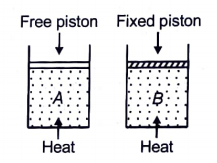If a gas changes volume from \(2\) litres to \(10\) litres at a constant temperature of \(300~\text{K}\), then the change in its internal energy will be:
1.
\(12~\text{J}\)
2.
\(24~\text{J}\)
3.
\(36~\text{J}\)
4.
\(0~\text{J}\)
| 1. | \(\Delta {U}=-{W}\) in an isothermal process. |
| 2. | \(\Delta {U}={W}\) in an isothermal process. |
| 3. | \(\Delta {U}=-{W}\) in an adiabatic process. |
| 4. | \(\Delta {U}={W}\) in an adiabatic process. |
An ideal gas heat engine operates in a Carnot cycle between 227ºC and 127ºC. It absorbs 6 × 104 cals of heat at higher temperatures.
The amount of heat converted to work will be?
1. 4.8 × 104 cals
2. 2.4 × 104 cals
3. 1.2 × 104 cals
4. 6 × 104 cals
Which one of the following processes is reversible?
| 1. | Transfer of heat by radiation |
| 2. | Transfer of heat by conduction |
| 3. | Isothermal compression |
| 4. | Electrical heating of a nichrome wire |
At a pressure of \(2\) atmospheres, a mass of diatomic gas \((\gamma = 1.4)\), is compressed adiabatically, causing its temperature to rise from \(27^{\circ}\mathrm{C}\) to \(927^{\circ}\mathrm{C}\). The pressure of the gas in the final state is:
1. 8 atm
2. 28 atm
3. 68.7 atm
4. 256 atm
Consider a cycle followed by an engine (figure).
1 to 2 is isothermal,
2 to 3 is adiabatic,
3 to 1 is adiabatic.
Such a process does not exist, because:
| (a) | heat is completely converted to mechanical energy in such a process, which is not possible. |
| (b) | In this process, mechanical energy is completely converted to heat, which is not possible. |
| (c) | curves representing two adiabatic processes don’t intersect. |
| (d) | curves representing an adiabatic process and an isothermal process don't intersect. |
Choose the correct alternatives:
| 1. | (a), (b) | 2. | (a), (c) |
| 3. | (b), (c) | 4. | (c), (d) |
The figure shows the \((P\text-V)\) diagram of an ideal gas undergoing a change of state from \(A\) to \(B.\) Four different paths \(\mathrm{I, II, III}\) and \(\mathrm{IV},\) as shown in the figure, may lead to the same change of state.

| (a) | The change in internal energy is the same in cases \(\mathrm{IV}\) and \(\mathrm{III}\) but not in cases \(\mathrm{I}\) and \(\mathrm{II}.\) |
| (b) | The change in internal energy is the same in all four cases. |
| (c) | The work done is maximum in case \(\mathrm{I}.\) |
| (d) | The work done is minimum in case \(\mathrm{II}.\) |
Which of the following options contains only correct statements?
| 1. | (b), (c) and (d) only | 2. | (a) and (d) only |
| 3. | (b) and (c) only | 4. | (a), (c) and (d) only |
The pressure and volume of a gas are changed as shown in the P-V diagram. The temperature of the gas will:
| 1. | increase as it goes from A to B. |
| 2. | increase as it goes from B to C. |
| 3. | remain constant during these changes. |
| 4. | decrease as it goes from D to A. |
Two cylinders contain the same amount of an ideal monoatomic gas. The same amount of heat is given to two cylinders. If the temperature rise in cylinder A is T0, then the temperature rise in cylinder B will be:

1.
2.
3.
4.
(where symbols have their usual meanings)
1. \(C_P = \frac{\gamma R}{\gamma-1 }\)
2. \(C_P-C_V= R\)
3. \(\Delta U = \frac{P_fV_f-P_iV_i}{1-\gamma}\)
4. \(C_V = \frac{R}{\gamma-1 }\)






